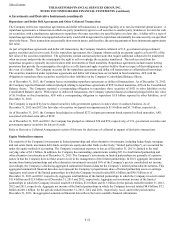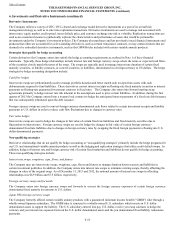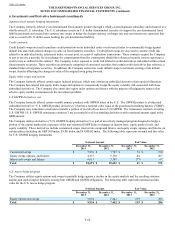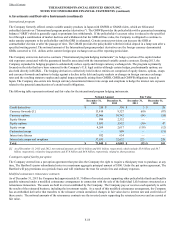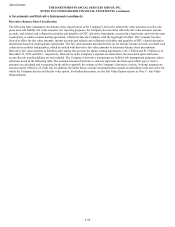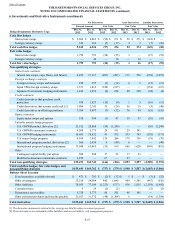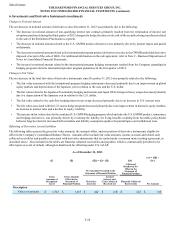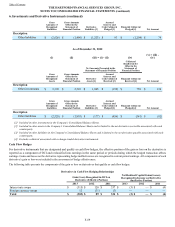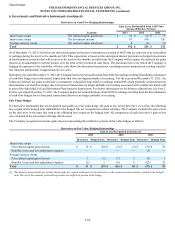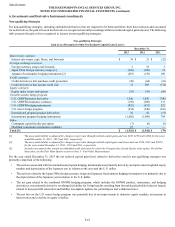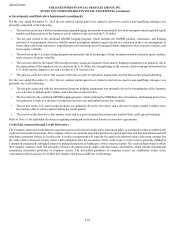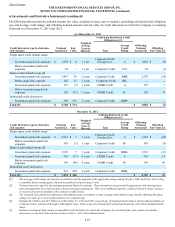The Hartford 2013 Annual Report Download - page 198
Download and view the complete annual report
Please find page 198 of the 2013 The Hartford annual report below. You can navigate through the pages in the report by either clicking on the pages listed below, or by using the keyword search tool below to find specific information within the annual report.
F-62
For the year ended December 31, 2012 the net realized capital gain (loss) related to derivatives used in non-qualifying strategies was
primarily comprised of the following:
• The net loss associated with the international program hedging instruments was primarily driven by an improvement in global equity
markets and depreciation of the Japanese yen in relation to the euro and the U.S. dollar.
• The net gain related to the combined GMWB hedging program, which includes the GMWB product, reinsurance, and hedging
derivatives, was primarily driven by liability model assumption updates largely related to a reduction in the reset assumptions to
better align with actual experience, outperformance of underlying actively managed funds compared to their respective indices, and
lower equity volatility.
• The net loss on the U.S. macro hedge program was primarily due to the passage of time, an improvement in domestic equity markets,
and a decrease in equity volatility.
• The net loss related to the Japan 3Win foreign currency swaps and Japanese fixed annuity hedging instruments was primarily due to
the depreciation of the Japanese yen in relation to the U.S. dollar, the strengthening of the currency basis swap spread between the
U.S. dollar and the Japanese yen, and a decline in U.S. interest rates.
• The gain on credit derivatives that assume credit risk as a part of replication transactions resulted from credit spread tightening.
For the year ended December 31, 2011 the net realized capital gain (loss) related to derivatives used in non-qualifying strategies was
primarily due to the following:
• The net gain associated with the international program hedging instruments was primarily driven by strengthening of the Japanese
yen, a decline in global equity markets, and a decrease in interest rates.
• The loss related to the combined GMWB hedging program, which includes the GMWB product, reinsurance, and hedging derivatives,
was primarily a result of a decrease in long-term interest rates and higher interest rate volatility.
• The net loss on the U.S. macro hedge program was primarily driven by time decay and a decrease in equity market volatility since
the purchase date of certain options during the fourth quarter.
• The loss on credit derivatives that assume credit risk as a part of replication transactions resulted from credit spread widening.
Refer to Note 13 for additional disclosures regarding contingent credit related features in derivative agreements.
Credit Risk Assumed through Credit Derivatives
The Company enters into credit default swaps that assume credit risk of a single entity, referenced index, or asset pool in order to synthetically
replicate investment transactions. The Company will receive periodic payments based on an agreed upon rate and notional amount and will
only make a payment if there is a credit event. A credit event payment will typically be equal to the notional value of the swap contract less
the value of the referenced security issuer’s debt obligation after the occurrence of the credit event. A credit event is generally defined as
a default on contractually obligated interest or principal payments or bankruptcy of the referenced entity. The credit default swaps in which
the Company assumes credit risk primarily reference investment grade single corporate issuers and baskets, which include standard and
customized diversified portfolios of corporate issuers. The diversified portfolios of corporate issuers are established within sector
concentration limits and may be divided into tranches that possess different credit ratings.
Table of Contents THE HARTFORD FINANCIAL SERVICES GROUP, INC.
NOTES TO CONSOLIDATED FINANCIAL STATEMENTS (continued)
6. Investments and Derivative Instruments (continued)


